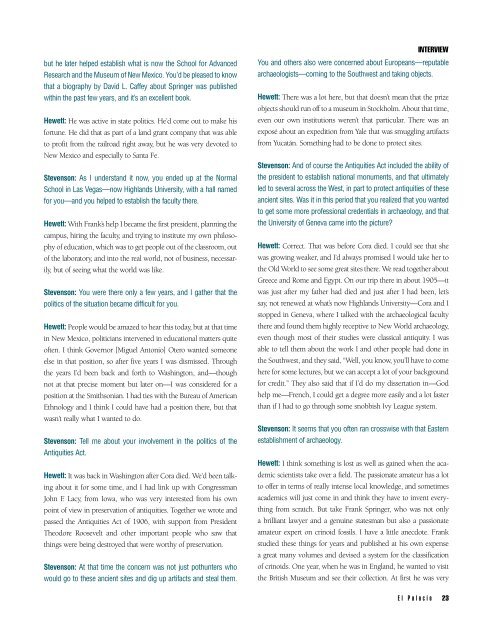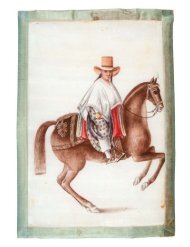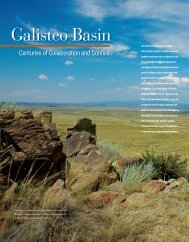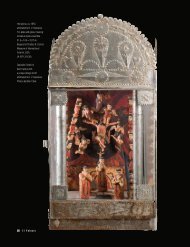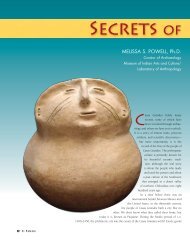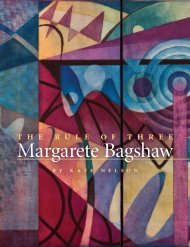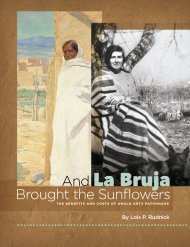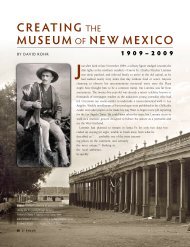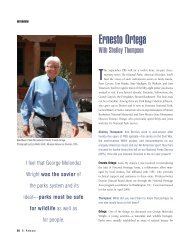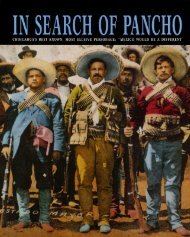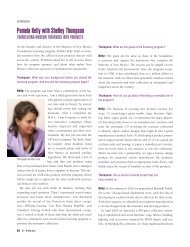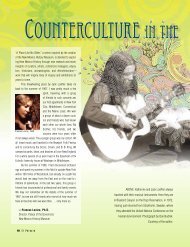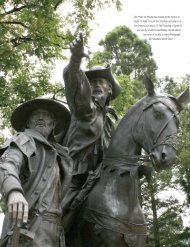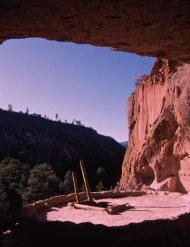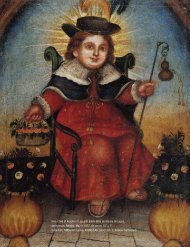Interview with Edgar Lee Hewett - El Palacio Magazine
Interview with Edgar Lee Hewett - El Palacio Magazine
Interview with Edgar Lee Hewett - El Palacio Magazine
Create successful ePaper yourself
Turn your PDF publications into a flip-book with our unique Google optimized e-Paper software.
ut he later helped establish what is now the School for Advanced<br />
Research and the Museum of New Mexico. You’d be pleased to know<br />
that a biography by David L. Caffey about Springer was published<br />
<strong>with</strong>in the past few years, and it’s an excellent book.<br />
<strong>Hewett</strong>: He was active in state politics. He’d come out to make his<br />
fortune. He did that as part of a land grant company that was able<br />
to profit from the railroad right away, but he was very devoted to<br />
New Mexico and especially to Santa Fe.<br />
Stevenson: As I understand it now, you ended up at the Normal<br />
School in Las Vegas—now Highlands University, <strong>with</strong> a hall named<br />
for you—and you helped to establish the faculty there.<br />
<strong>Hewett</strong>: With Frank’s help I became the first president, planning the<br />
campus, hiring the faculty, and trying to institute my own philosophy<br />
of education, which was to get people out of the classroom, out<br />
of the laboratory, and into the real world, not of business, necessarily,<br />
but of seeing what the world was like.<br />
Stevenson: You were there only a few years, and I gather that the<br />
politics of the situation became difficult for you.<br />
<strong>Hewett</strong>: People would be amazed to hear this today, but at that time<br />
in New Mexico, politicians intervened in educational matters quite<br />
often. I think Governor [Miguel Antonio] Otero wanted someone<br />
else in that position, so after five years I was dismissed. Through<br />
the years I’d been back and forth to Washington, and—though<br />
not at that precise moment but later on—I was considered for a<br />
position at the Smithsonian. I had ties <strong>with</strong> the Bureau of American<br />
Ethnology and I think I could have had a position there, but that<br />
wasn’t really what I wanted to do.<br />
Stevenson: Tell me about your involvement in the politics of the<br />
Antiquities Act.<br />
<strong>Hewett</strong>: It was back in Washington after Cora died. We’d been talking<br />
about it for some time, and I had link up <strong>with</strong> Congressman<br />
John F. Lacy, from Iowa, who was very interested from his own<br />
point of view in preservation of antiquities. Together we wrote and<br />
passed the Antiquities Act of 1906, <strong>with</strong> support from President<br />
Theodore Roosevelt and other important people who saw that<br />
things were being destroyed that were worthy of preservation.<br />
Stevenson: At that time the concern was not just pothunters who<br />
would go to these ancient sites and dig up artifacts and steal them.<br />
INTERVIEW<br />
You and others also were concerned about Europeans—reputable<br />
archaeologists—coming to the Southwest and taking objects.<br />
<strong>Hewett</strong>: There was a lot here, but that doesn’t mean that the prize<br />
objects should run off to a museum in Stockholm. About that time,<br />
even our own institutions weren’t that particular. There was an<br />
exposé about an expedition from Yale that was smuggling artifacts<br />
from Yucatán. Something had to be done to protect sites.<br />
Stevenson: And of course the Antiquities Act included the ability of<br />
the president to establish national monuments, and that ultimately<br />
led to several across the West, in part to protect antiquities of these<br />
ancient sites. Was it in this period that you realized that you wanted<br />
to get some more professional credentials in archaeology, and that<br />
the University of Geneva came into the picture?<br />
<strong>Hewett</strong>: Correct. That was before Cora died. I could see that she<br />
was growing weaker, and I’d always promised I would take her to<br />
the Old World to see some great sites there. We read together about<br />
Greece and Rome and Egypt. On our trip there in about 1905—it<br />
was just after my father had died and just after I had been, let’s<br />
say, not renewed at what’s now Highlands University—Cora and I<br />
stopped in Geneva, where I talked <strong>with</strong> the archaeological faculty<br />
there and found them highly receptive to New World archaeology,<br />
even though most of their studies were classical antiquity. I was<br />
able to tell them about the work I and other people had done in<br />
the Southwest, and they said, “Well, you know, you’ll have to come<br />
here for some lectures, but we can accept a lot of your background<br />
for credit.” They also said that if I’d do my dissertation in—God<br />
help me—French, I could get a degree more easily and a lot faster<br />
than if I had to go through some snobbish Ivy League system.<br />
Stevenson: It seems that you often ran crosswise <strong>with</strong> that Eastern<br />
establishment of archaeology.<br />
<strong>Hewett</strong>: I think something is lost as well as gained when the academic<br />
scientists take over a field. The passionate amateur has a lot<br />
to offer in terms of really intense local knowledge, and sometimes<br />
academics will just come in and think they have to invent everything<br />
from scratch. But take Frank Springer, who was not only<br />
a brilliant lawyer and a genuine statesman but also a passionate<br />
amateur expert on crinoid fossils. I have a little anecdote. Frank<br />
studied these things for years and published at his own expense<br />
a great many volumes and devised a system for the classification<br />
of crinoids. One year, when he was in England, he wanted to visit<br />
the British Museum and see their collection. At first he was very<br />
<strong>El</strong> <strong>Palacio</strong> 23


